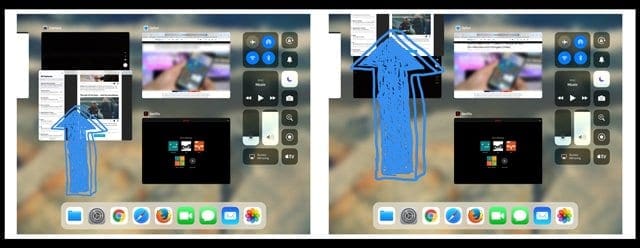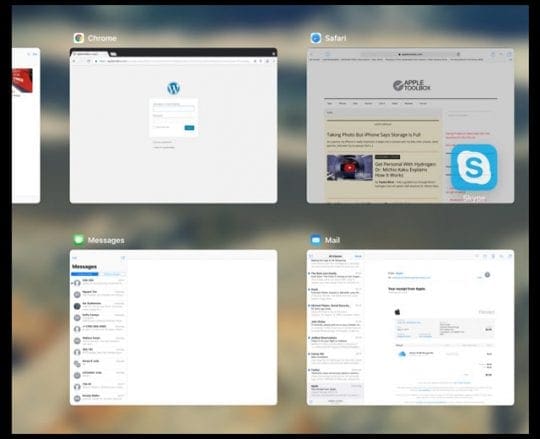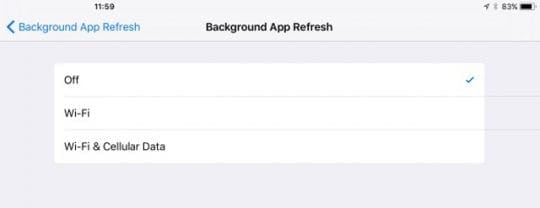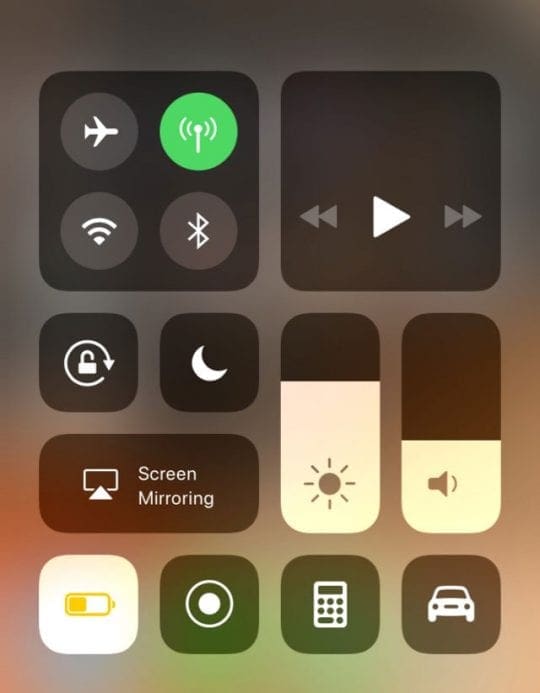iOS 11 introduces a new app switcher to move between and force close apps on your iPad. Swipe up towards the top of your screen thankfully still works–it just looks a little different than iOS10. And the App Switcher is still a quick and efficient way to change to other recently used apps easily.

Contents
- 1 Closing apps on your iPad is a two-step process
- 2 And sorry…still no close all feature
- 3 Looking for an easy way to switch between apps on your iPad? Switching Apps is Easier Than Ever!
- 4 Turn Multitasking features ON (or off)
- 5 Not Sure How To Close A Multitasking App?
- 6 Use Your Dock!
- 7 About Apps Running in Background
Related Articles
- Customize Your Control Center in iOS 11 and above
- Learn All About Your iPad Dock in iOS11
- How-To Drag & Drop with iOS
- Common iOS 11 Problems and How To Fix Them
- Error Occurred Installing iOS 11 on iPhone or iPad, How-To Fix
- Record Your iPhone or iPad Screen Without a Third-Party App in iOS11
- Free Up Some Space with iOS 11 Manage Storage Recommendations
- Where’s AirDrop in iOS11?
- 11 Tips for Making the Best in iOS11 Mail App
Closing apps on your iPad is a two-step process
First, bring up your app switcher by pressing Home twice. Or if you have multitasking gestures turned on, open the app switch screen by quickly swiping upwards on your iPad’s screen with four or more fingers. Second, press and hold on any app’s preview in the App Switcher. Maintain this hold and swipe up towards the top of the screen.

And sorry…still no close all feature
Some folks were hoping for a close all apps button in iOS11 (also called the kill-all option). But no go. Apple still doesn’t include the ability to close all apps in iOS and all its iOS-running devices (iPhone, iPad, iPod Touch.) The main reason iOS does not include this close all option is Apple’s tight control of its multitasking ecosystem. When working correctly, most apps aren’t taking up much or any memory when sitting in the background.
Think of background apps like a cache–information that’s kept in a suspended state AND NOT using any battery or system resources. The exception is apps that frequently refresh in the background–like weather, mail, navigation, and similar apps that routinely pull and update data. These apps are still in a suspended state but continue to update using background refresh. Read further for more on background app refresh.
Ideally, this means that those background apps are NOT impacting the function of your device at all. Routinely closing non-problematic apps can even shorten your battery life. So unless you are experiencing problems, best leave your apps alone.
When Closing Apps Makes Sense
When an app stops responding or responds very slowly, you should close that offending app. And use swipe to kill when an app or certain parts of your iDevice completely crash or start acting nonresponsive.
And if your iPad runs a little slow or lags, it’s a good idea to close some or all of your most recently used apps. Apple’s iOS operating system keeps your recently used apps in the background, just in case you want to switch back to them. So closing problematic apps often frees up the memory maintaining these background apps. That usually translates into a zippier experience with your current and active app.
Bear in mind that the App Switcher shows all apps that you’ve recently opened on your iPhone, iPod Touch or iPad. It does not currently differentiate whether or not they are actually running in the background and getting refreshed. To find out what apps are refreshing in the background and how to enable or disable this feature, keep reading!
Looking for an easy way to switch between apps on your iPad? Switching Apps is Easier Than Ever!
iOS 11 makes it simple to switch between apps using the redesigned App Switcher and the new iPad Dock. Now, you have choices–change apps by calling up your Dock or by using the App Switcher for all open apps. Quickly flick up from screen bottom to reveal the Dock or swipe up more from the bottom to reveal the App Switcher. Alternatively, double press Home to show the App Switcher.

Swipe right to see all your open apps in the App Switcher. You see preview tiles of all open apps. Once you find the app you want, just tap the preview tile with your finger, and that app opens. If you recently used it, it usually picks up where you left off. Some apps, in particular, game apps, need to relaunch to work fully.
Turn Multitasking features ON (or off)
Turning on Multitasking Gestures makes accessing your App Switcher easy–just a quick swipe with four fingers. To turn Multitasking features on go to Settings > General > Multitasking > Gestures. This feature enables you to use four or five fingers to access the App Switcher by swiping up. Also, Gestures allows quick access to the Home Screen via a pinch and swiping left or right shows you all currently open apps.
And our favorite Multitasking gestures still work on iOS 11, including:
- Return to the Home screen: While using an app, pinch four or five fingers together on the screen
- See the app switcher: Swipe up with four or five fingers or double-click the Home button. Then swipe right or left with one finger to find and open a different app
- Switch apps: Swipe left or right with four or five fingers to switch to a previously used app
Not Sure How To Close A Multitasking App?
So you got your apps arranged next to each other or floating on top of each other on a single screen. But then you want or need to dismiss and close just one (or two) of those apps while leaving the others intact. Hey, wait a minute…HOW DO YOU DO IT?
Yup, me too! I swipe to the right—nope. Then swipe to the left—nope. Swipe up—nope. Swipe down—no! What the heck?
So closing apps while in multitasking view is challenging and not very user-friendly—at least not at first. There’s a learning curve here, and it takes a little getting used to. So here’s it is:
If you’re in split-screen view, grab the center handle of the app you want to close and move the app passed the left or right edge to dismiss and close it from multitasking.
If you’re in floating view, touch the handle at the top of the floating window OR touch the LEFT edge of the app and move it off the screen all the way to the right. Remember, it’s always LEFT to RIGHT.
And one more thing: floating apps reappear
You can also bring back that floating app by swiping from the right edge of the screen to the left—but it only brings back the last app floated off-screen. So if you have more than one floating app and dismiss them both, your iPad brings back the most recent dismissal.
Use Your Dock!
One of the best new features hitting your iPad in iOS11 is the new iPad Dock! Mac users know this feature well–it sits at the bottom of your screen and allows easy access to all your favorite apps. It’s customizable and follows you from app to app when you want. A quick swipe up and your Dock appears. Swipe up a little further, and your App Switcher appears. It’s that easy and convenient.

Learn more about iOS11’s iPad Dock in our detailed article.
About Apps Running in Background
When you switch to or open a new app, some apps continue to run for a short period of time before they move into a suspended state. When Background App Refresh is enabled, even suspended apps periodically check for updates and new content. That means that your suspended apps potentially take up system memory and drain your battery. This makes sense for apps like News, Maps, Mail, Messages, Twitter, FaceBook, and other social media. But for things like Netflix, Amazon, Photos, and others, background app refresh is really not necessary. And it ends up just depleting your battery and possibly consuming data from your mobile data plan. Consequently, we recommend turning off background app refresh for these types of apps or even all apps.

So if you want suspended apps to NOT check for new content, go to Settings > General > Background App Refresh and either turn OFF Background App Refresh entirely or select which apps you want to refresh in the background. In iOS11, you also set whether you want Background App’s to refresh using WiFi only or when using both WiFi & Cellular Data.

Apps Always Refresh When Opened
If you’re worried that turning off background app refresh means your apps don’t populate with updates, never fear! As soon as you open any app, it automatically calls to the server to update any information. As long as you connect to data via WiFi or Cellular, your apps should always feature new information.
What About iPhones?
For now, closing apps on iPhones remains the same as earlier versions of iOS. Double-click the Home button to see your most recently used apps, swipe right or left and locate the app that you wish to close, and finally, swipe up on the app’s preview to close the app. Remember that apps appearing in the App Switcher are not open. They’re in standby mode to help you navigate and multitask. Apple recommends only forcing an app to close when it’s unresponsive, erratic, or if you’re experiencing problems with your iDevice’s performance and/or battery.
Worried About Your Battery Performance? 
If concerned about battery life, try lowering your screen brightness, turning off Bluetooth, switching on Low Power Mode, and disabling Background App Refresh for all apps, especially apps that use Location Services in the background (like Maps, Yelp or Waze, etc.) And if you don’t need Internet access, also turn off WiFi. Better yet, add Low Battery Mode to your Control Center via Settings > Control Center for easy on and off. Please note that Low Battery Mode is currently not available on iPad.